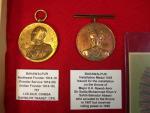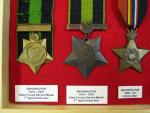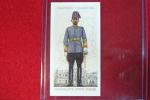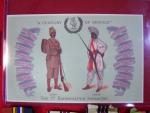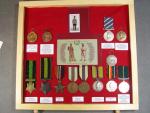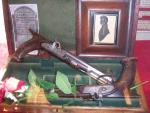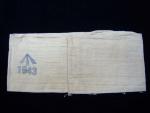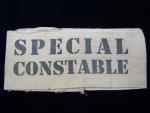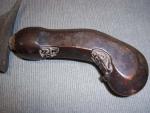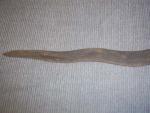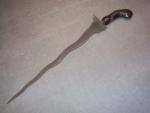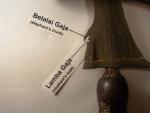-
Posts
6,486 -
Joined
-
Last visited
-
Days Won
10
Content Type
Profiles
Forums
Blogs
Gallery
Events
Store
Everything posted by Brian Wolfe
-
Here are two more without their ribbons. One is a bit of an imposter in a manner as I have printed a ribbon from the internet that was the correct size and have used it here. Did you notice?
-
Here are a couple missing their ribbons. The Northwest Frontier medal is sometimes called the Camel Corps medal. Note the finger prints on this medal; that's why you don't touch your medals with bare hands (this one arrived in that condition).
-
In some cases where I have two medals the same I use one to show the reverse as in the case of the 1939-45 Overseas Service Medals shown in this photo.
-
Here are the closeups of the medals. I won't describe each one as the card with each medal covers that aspect. The 1st type bronze star WW I came with a ribbon that was very fragile so I just tacked (single stitched) the medal to the ribon and kept the ribbon flat. Anyone who has collected Bahawalpur will know that quite often the ribbon is much harder to find than the medal itself. This is why some are missing their's.
-
Next up is a John Player & Sons tobacco card showing an officer in dress uniform of the Bahawalpur State Forces.
-
Here is a nice postcard commemorating 100 years of service, 1834 to 1934 of the 1st Bahawalpur Infantry. It shows the two uniforms quite well and lests the battle hounors. This may not be too clear so I'll list them below. 1st Kabul War 1837 Multan Campaign 1848 Mutiny 1857 2nd Kabul War 1879 The Great War 1914 - 15 East Africa 1915 Suez Canal, Egypt 1915 - 17 Waziristan 1917 Ghaza "Magiddo" 1917 Nablus 1917 - 18 Palistine 1918 Jordan Valley 1918 Marri Field Force 1918 Persian Gulf 1918 Afghanistan 1919 Kot Sabezal 1930 An impressive list for such a small country. Regards Brian
-
Hi James, I thought I'd pull my drawer of Bahawalpur material out of the cabinet and post it here, just to keep the post "alive" a little longer. The first photo is of the whole collection, as modest as it is. I'll break it down into closer pictures of the material for clairity. I won't photograph the reverse as anyone interested can access the links you have so kindly provided. Regards Brian
-
Hi James, Good points. As to why anyone would refer to Bahawalpur as Indian I can only speak for myself,it is out of habit and going by others who have more knowledge about this issue than me. That is why I asked. Taking only one point of view as the only point of view can be misleading. Thanks again for your fast reply. I hope others who are collecting Bahawalpur will read your post and share their collections with us. Regards Brian
-

Dueling pistols from Perth Ontario
Brian Wolfe replied to Brian Wolfe's topic in Firearms & Ordnance
Hi Mervyn, No I could not see the maker's name. The regular museum staff would have opened the case for me, I am sure, as my wife is a "native" of Perth. They have been most helpful in the past. However on the weekend, when we were there, only summer student help was on duty and they would never take that much liberality. I would not expect them to do so. The next time we are in Perth through the week I will ask the curator to allow me to see them and perhaps handle them more closely, with white gloves on of course. I would think these pistols would command a very high price at the time they were purchased. I would not hazard to guess what they would be worth today given their historic value. Regards Brian -
Many thanks for this post James, the post and its links will be most helpful for those, like myself, who collect Bahawalpur. I am far from an expert on Bahawalpur but this is the first time I have seen it referred to as a Pakistan Princely State. I've seen it only as an Indian Princely State. Bahawalpur and the area now know as Pakistan were in India prior to 1947. I pose this as a question not as a criticism. Is the proper term "Pakistan Princely State" or is "Indian Princely State" the proper term? Thanks again for your post and for any help you can give regarding my question. Regards Brian
-
Hello Everyone, About a year ago I posted photos and a write-up about two cannons in front of the Perth Court House in Perth Ontario. Last week we took a 5 hour drive up to Perth to have dinner with my wife's family (returning Sunday morning) but before we left we stopped in at the Perth Museum to take a photo of these dueling pistols. These are the actual pistols used by John Wilson and Robert Lyon on 13 June 1833 in what was to be the last duel ever fought in Upper Canada (now Ontario). The duel was fought over a young lady, Miss Elizabeth Huges. Both Mr. Wilson and Mr. Lyon missed on their first round and were perpared to shake hands and call it a day except Mr. Lyon's second, Mr. Henry LaLievre insisted they give it another go. This time Mr. Lyon was shot just under his outstretched arm and his heart was pierced. He was 19 years of age. As usual there is more to the story both prior to and after the duel so I would suggest you go to the following link for some interesting Canadian history. Only a Canadian can call our history interesting without smiling. My link In case I messed up posting the link properly, it is http://www.rideau-info.com/canal/tales/last-duel.html I'm having problems with the link. The word after "rideau-" is "info", For some reason this is not coming out correctly when I post. Anyway, do check it out. I do not know the calibre of the pistols and the musuem staff could not help as they were students filling in for the summer. I hate that someone placed a red rose in the case. Very artsie but out of place, IMHO. You can see a photo of Mr. Lyon's tombstone mounted in the case and a siloette of him to the right. If anyone can help with the calibre it would be apresiated. I would not be surprised to find it is a 50 cal. Regards Brian
-
Here is the reverse side of the arm band showing the British Army broad arrow mark and the date of 1943. This begs the question as to why this seems to be an official War Department issue rather than being from a municipality as is the case of all of the other Specials memorabilia in my collection. Would this be issued to a civilian Special Constable who was guarding a government installation? Comments are, as always, welcomed. Regards Brian
-
Continuing with my post of my collection of Special Constabulary memorabilia here is an item that came in a few weeks ago. It is a cloth arm band from the WW II era and marked 1943. The arm band in the photo measures 9 cm wide and 22 cm in length. It is stitched and was held in place by safety pins or at least from what I am told. If it were not stitched into a circle it would measure 9X44 cm. I have not seen many of these offered and the seller on eBay listed it as "VERY RARE!". Anyone else find this brings a smile to your face? Regardless of the description on eBay I do like this arm band as it is clearly marked as to date and government "ownership". Regards Brian
-
Hello Mervyn, Is it your intention that this "short post" is for early prints or early police memorabilia in general? My reason for asking is that I have a great item from the Victorian period, Staffordshire Police, on its way from the UK. I can't tell you what it is due to "collector's superstition" but I think it is the Holy Grail of my Staffordshire Police collection. Regards Brian
-
Mine cost me little as well but then I purchased in in the early 1970s. In a lot of shops things like these were considered "junk". Oh, to return to those times with today's income. I have more information on the religious aspect of the kris and I'll post it later when time permits. Regards Brian
-
This last photo shows the handle or the Ulu. The metal decorative bit between the blade and the handle is called the penongkoh. Some of these can be very ornate. Regards Brian
-
This is the section of the blade near the handle or Ulu. The deep groves on this specimen were produced when the metal was folded time and time again to create the blade.
-
-
-
The gaja is found on the older more traditional kris. Hugh, that's not to say yours in not old only that the older ones are more likely to have them. The book I have deals with the use more than the traditions so I don't know the reason for the elephant design other than it is a traditional symboland that the first krises were made by a Hindu population, before the introduction of Islam. Tradition has it that the deadliness of the blade increases with the number of vaves, though you will find krises also made without any waves such as the Celebes kris. Krises are made with as many as 19 waves and there are always an odd number of waves. The only source of iron was from meteoites in the ancient times and this was used to make the kris. Of course as trade became established with other cultures iron was imported. The undulate blade facilitates penitration between bones and sinews. The blade seems fragil (and it is) compaired with other fighting knives and swords and one may wonder how these survived use considering the strength of other weapons. It must be remembered that these were the only weapons in use at this time so if everyone had these then they were the state of the art in fighting weapons at that time. Oh yes, if anyone reading this post decides to purchase a kris be sure you do not try to remove the rust that covers all older blades. It is important to not remove this as you will spoil the blade completely, the rust is part of the finish. Some Japanese armour also has this style of finish and it was done on purpose.
-
Hello Mervyn, I have been looking for that book that deals with the Kris and I have found it. It is titled, "Asian Fighting Arts" by Donn F. Draeger and Robert W. Smith. I've had this book since 1974 and the pages are turning brown with age and I treat it with extra care. It seems like every little part of the Kris has a name but I will only deal with the "notch". The "notch" represents an elephant's head. In the attached photo you can see the trunk, called the Belalai Gaja and the smaller point which represents the elephant's tusk called the Lamba Gaja. In some later examples this has all but disappeared but in the older blades it is quite prominent. Thanks for giving me the nudge to do some more research, Mervyn. Regards Brian




